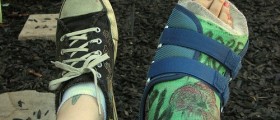
About Boxer's Fracture
A boxer's fracture (also known as the brawler's fracture) is a term used for a fracture of the neck of a metacarpal bone. This bone is anatomically divided into several parts: the body, the base and the head. The head of the metacarpal bone is a part of the knuckle joint. In majority of cases fracture affects the fifth metacarpal bone.
This type of fracture develops as a consequence of punching an object with a closed fist. It is a common injury during fist fights and may also occur due to punching a hard object such as a wall. Even though in many cases the hand is in a fist, boxer's fracture may also occur when the hand is not clenched.
This type of fracture is typically characterized by pain and tenderness located at the very site of the injury (around the fractured bone). Pain intensifies with movement of the hand and fingers. The very fracture can be accompanied by a snapping or popping sensation. After a while the injured area becomes swollen, there is skin discoloration and bruising. In some cases there is evident deformity of the broken bone and the knuckle.
In order to confirm or rule out boxer's fracture the doctor performs physical examination and performs X ray of the injured hand. X-ray is essential and represents an excellent tool for setting the diagnosis of boxer's fracture.
Therapy for Boxer's Fracture
Immediately after the injury the person should take proper measures in order to minimize swelling and pain and prevent infection in case of open cuts. It is also essential to prevent further injury if the fracture is not stable. Pain and swelling can be initially reduced with ice packs. If there is a cut it should be washed with soap and water and covered with a clean bandage.
In order to prevent further damage to the surrounding structures the best thing one can do is to immobilize the injured hand. The simplest way to immobilize the injured hand is to hold it in the uninjured hand.
After being examined by the doctor patients are prescribed with pain killers. In many cases of boxer's fracture when patients do not require immediate surgery the injured hand is placed into a splint or a cast. If the swelling increases, the patient may feel the pain under the cast/splint or suffer from numbness and tingling sensation. In such case splints and casts are removed. If there are open cuts, the wound is properly cleaned and covered until it completely heals. And finally, patients are advised to monitor cuts for any signs of infection. Warning signs of wound infection include redness of the nearby skin, redness streaking away from the cut, warmth and swelling of the injured area.

















Your thoughts on this
Loading...